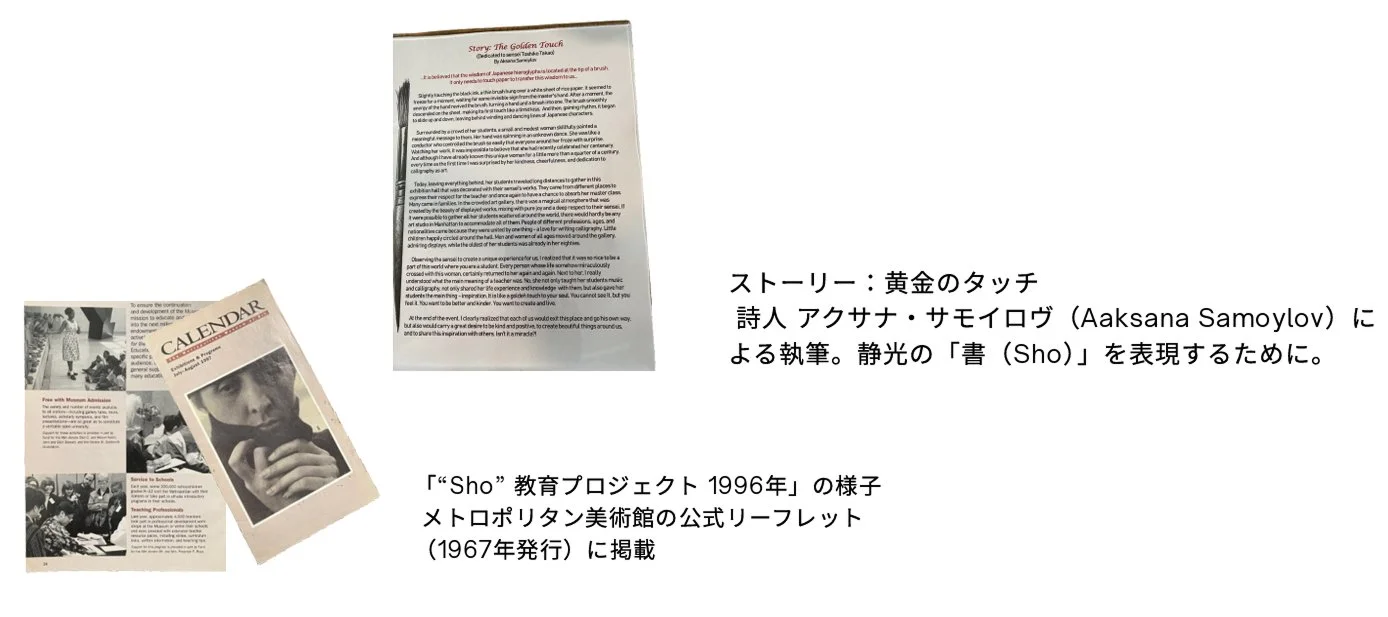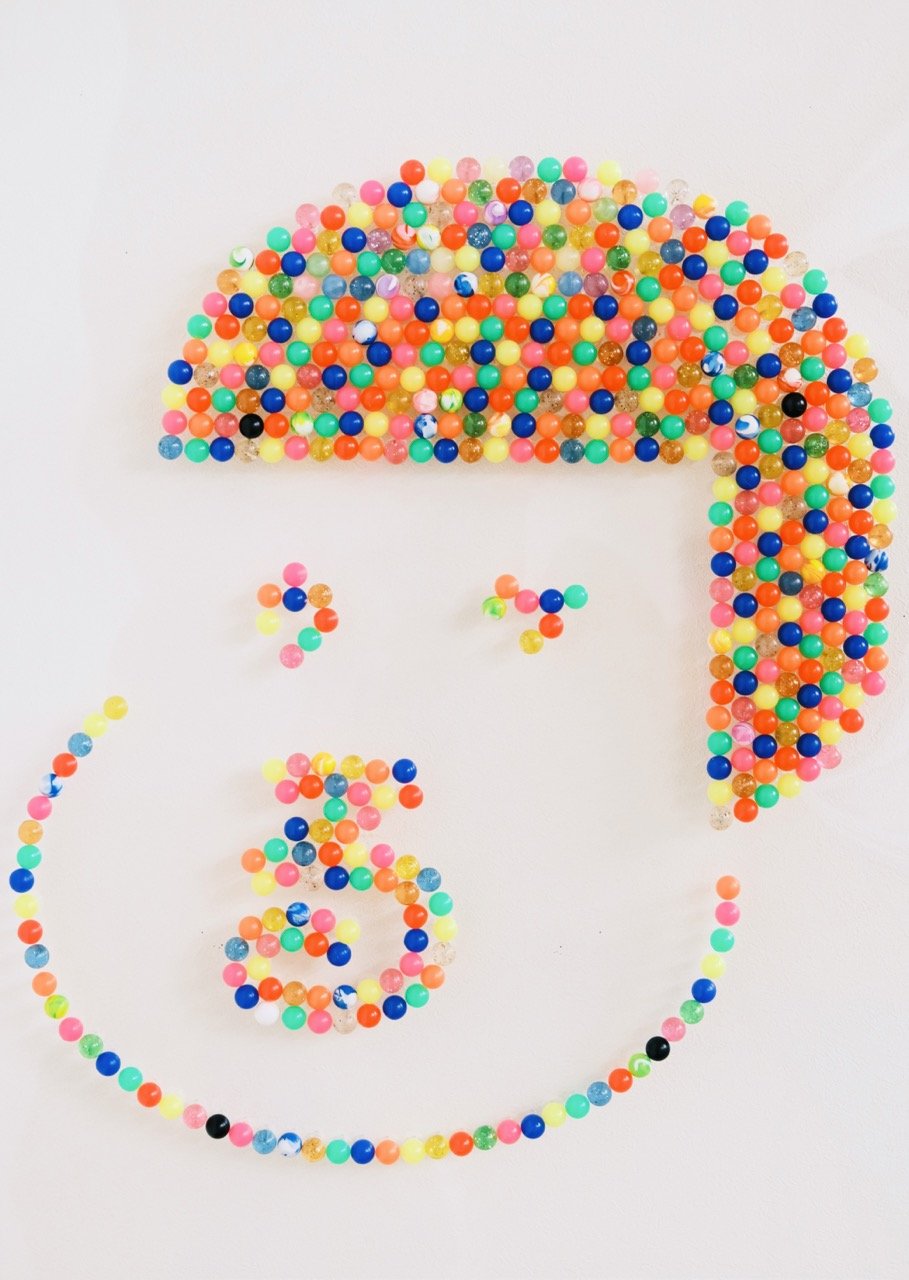Guest Artists

書を通じて美と感性を育み、⽇⽶をつなぐ。
102歳の 現役書家ニューヨーク在住
100年を ⽣きてきた、正確には現在102歳の 静光(SEIKOU)は 、第⼀次世界⼤戦後の 1922年、福岡県に⽣まれ、⾃由な家庭で芸術を愛する心を育む。「美しいものを⾒て、素直に美しいと感じられる心こそ人を幸せにする」と信じ、その想いを⽣涯⼤切にしてきた。
教育の平等を信じ、教師を志す。⼩学校教員として働く中で感性を磨くことへの興味が捨てられず、教員を続けながら音⼤に進学。卒業後は音楽教師として、子どもたちの中に眠る感性を育てることに⼒を注いだ。退職後、アメリカに住む息子を訪ねたことが転機となる。滞在中、柔軟な感性と教育者としての経験を評価され、⽇本の教育理念をアメリカに伝えるという構想の⼀端を担うことに。その中心にあったのが、⽇本の精神性を象徴する「書」だった。
1996年にはメトロポリタン美術館の教育者向けプロジェクトに参加し、「書」を通じた教育ワークショップを実施。短期滞在のつもりが、気づけば半世紀近くニューヨークを拠点に、⽇本文化の伝承者として歩み続けている。SEIKOUにとって「書」は技術を超えた芸術表現。筆に心を重ね、⽩紙に想いを映す。「書」とは、⾃分⾃身と素直に向き合うことで初めて語りかけてくるもの。SEIKOUの 「書」の 教えを求めて訪れる⽣徒は絶えず、いまもなおニューヨークで「書」を教え続けている。
⾒えざる⼒
墨、和紙
閉じられた番傘がひとつ。⾬も降らず、⾵もない。しかし、何も起こっていないということではない。⾒えない⼒がいつもあり、いざという時、傘は開かれるのだ。
⾵不鳴篠とは、「⾵が吹いていないのに、枝が鳴る」という中国の古典に由来する。表⾯上は何も起こっていないようでも、実は何かが動いているということ。
世界は、たとえ安定しているように⾒えても、水⾯下では⾒えない⼒で支えたり、動かしていることもある。真の天下泰平には、お互いの理解と尊重と協⼒が不可欠であるのだ。⾒えざる⼒で支えらた平和、それがいまこそ必要である。

禅僧・書家 ∕ 京都・⼤徳寺⻩梅院 第⼆⼗世住職
1938年⽣まれ。6歳で 両親を 失い 、出家。花園⼤学卒業後、臨済宗相国寺派の僧堂にて、⼤津櫪堂(おおつ れきどう)⽼師のもとで禅修⾏に励む。
1975年、臨済宗⼤徳寺派 ⼤本山⼤徳寺の 塔頭・ ⻩梅院(おうばいいん)第⼆⼗世住職に就任。当時、建物や庭園が荒れ果てていた⻩梅院を、長年にわたる尽⼒によって復興・整備し、今⽇の姿へと再興した。
⼤徳寺は、室町時代から続く京都の禅寺で、茶道文化との結びつきが深いことで知られる。なかでも⻩梅院は、戦国時代に織⽥信長の菩提を弔うために建立され、千利休が庭園を作庭したと伝えられるなど、禅と茶の精神が共鳴する特別な空間である。
⼩林太玄は、禅の修⾏に裏打ちされた深い精神性と、書家としての感性をあわせ持ち、現代に禅の教えと美意識を伝える存在として、国内外で高い評価を受けている。
円相 Ensō – Zen Circle of life
墨、和紙
円相とは、禅において「真理」や「宇宙の全体性」「悟り」を象徴する形です。⼩林太玄⽼師の筆から⽣まれたこの円には、⽣死を超えて続いていく命のつながりが表現されています。
⽼師は言います。「⽣から始まり死で終わるのではなく、円のように命は次へとつながっていく。この円相はそんな考えを表現しています。仏教は宗教ですが、科学や哲学に通じる視点があります。例えば、“天国”を 心の 中や 空のどこかに“この 世で 幸せに ⽣きる 時間”こそが天国であると捉えます。」
そのために⼤切なのが、「⾃利利他」と「善根功徳」という禅の精神です。⾃分の喜びが他者の喜びにつながり、善き⾏いがやがて⼤きな福徳へと育つ。
⽼師はこうも語ります。「世の中にはさまざまな考え方や立場の違いがあるけれど、どの道も本来は“人びとが願っているはず。だからこそ、人としての道を⾒失わず、笑って、楽しく、幸せに⽣きることが⼤切です」
この円相は、そうした禅の叡智と祈りを、⼀筆に込めたものです。あなたの心の中にも、この円のようなつながりと調和が響きますように。
※本作品は 、京都の 表具師職人に 現代の ⻄洋住宅にも 飾りやすいスタイルで掛け軸に仕立て頂きました。作品を保管する桐箱もお渡しさせて頂きます。また本作品の売上の⼀部は、⻩梅院に寄付させて頂き、庭や伝統文化財の維持に活⽤されます。

ゴスペルシンガー
TiA (ティア)2004年、16歳で Sony Music レーベルズ EPIC Records Japanより 14歳で ⾃身作詞作曲の 「Every time」が HEY!HEY!HEY! MUSIC CHAMPのEDとなりメジャーデビューNARUTOのエンディングテーマに。2nd Single「流星」は 人気アニメ抜擢。1st Album「humming」が 【⽇本ゴールドディスク賞】ニュー・アーティスト・オブ・ザ・イヤーを受賞。
2014年より単身渡⽶、ニューヨークを拠点に活動。2万人のスタジアムで⾏われたアメリカ最⼤のゴスペル⼤会で⽇本人初優勝。The New York Times誌⼀⾯に 異例の 特集が 組まれ 、『クーリエジャポンャパニーズ6人“に ⼤谷翔平らと 選出。TBS「UTAGE!」「モニタリングNHK「うたコン』“世界が 認めたジ」」⽇本テレビ「今夜くらべてみました」テレビ朝⽇「題名のない音楽会」テレビ朝⽇「SONG vs DANCE」フジテレビ「サンシャイン」「ノンストップ」など多数のメディアに出演。堺正章が司会を務めるテレビ東京「THE!カラオケ★バトル」では2度の 優勝を 果たし 、⼀躍その 名が注⽬された。
2025年5⽉、ニューヨークでにてTiA率いる⾏われたマクドナルドゴスペルフェスト2025 Sakura Japanese Choirがクワイア部⾨にて優勝の歴史的快挙がニュースとなっている。









